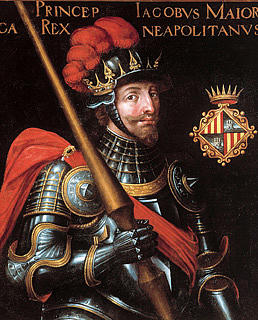In 1349, having acquired an army to go with his borrowed fleet, James III of Majorca, accompanied by his teenage son James jr., launched an attack against his Aragonese enemies, who had taken over the island of Majorca. The invasion, however, failed spectacularly. The King was killed and his son, James IV, was captured and imprisoned, and remained “shut up for the next 14 years in an iron cage”.
James finally managed to slip away in 1362, just in time to marry by proxy Queen Joanna I of Naples (1328-82) on December 14. The timing of his breakout is coincidental enough to suggest that the court of Naples may have had something to do with his escape. After spending his youth in hopeless captivity, James suddenly found himself free and paired to a Queen of a large and strategically located realm, who could provide him with the means to regain his throne.
 |
| Queen Joanne I of Naples
|
On May 16, 1363 the bridegroom and his retainers sailed into the harbour of Naples, accompanied by a flotilla of 7 ships. Banquets, processions and other public festivities followed and then, in a solemn ceremony at the Castel Nuovo, Joanna took James IV as her 3rd husband.
Early in the marriage, Joanna discovered that her new husband was mentally unbalanced and given to violent episodes. Although James had signed a marriage contract specifically waiving any rights to encroach upon his wife’s authority, within days of arriving in Naples James began demanding that he be ceded control of the Kingdom. When Joanna refused, James flew into feverish rages, ranting irrationally and threatening both his wife and her Kingdom. Joanna feared James “as her husband and dreads him as the devil, as not only did his lengthy incarceration affect the soundness of his mind, but also because he is, according to the doctors, eccentric by nature and like mad, which his words and deeds show, alas!” the archbishop told the pope.
James suffered from fits of fever, heavy sweating, enemas, and other inconveniences. Joanna tried to cover up the marital incidents of aggression, and tried to be patient, but James persisted in demanding authority. For as long as possible, Joanna concealed her husband’s dementia from all but her most intimate counsellors.
On January 4, 1364, James engaged in a very public display of domestic violence, which caused a great scandal at court and throughout the capital. “Afflicted with a fit of fever, he carried out even more outrageous deeds,” Joanna wrote to the pope. She “began to notice that every month, sometimes at the change of the moon, and sometimes just after the full moon, he would have an outbreak of madness with some clear-sighted moments at intervals”.
Many famous physicians were consulted in an effort to cure James. The Queen watched her husband’s diet carefully. Despite her fear of James’s outbursts, in 1365 Joanna had resumed sleeping with her husband, an indication of just how desperately she sought to provide a child of her own as heir to the Kingdom. In January 1365 the 39-year-old Queen of Naples was pregnant, but jubilation turned to despair in June, when Joanna miscarried.
On April 3, 1367, James IV took part in the battle of Najara, Spain, with the English Black Prince. Afterwards James marched his men to Burgos. He fell ill, became incapacitated, and was thus captured by the future King Henry II of Castile. He was imprisoned in the castle of Curiel. After Queen Joanna had ransomed her husband, James immediately began raising more money for a new, rash war against Aragon. In Avignon he acquired more troops. With the consent of the King of Navarra, James advanced into Aragon, taking and destroying small forts until he fell sick again at Val di Soria. His disorder increased so much that he died on January 20, 1375.




